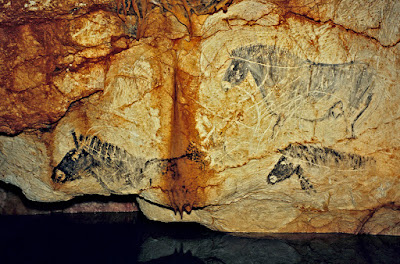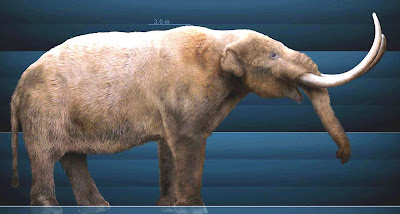Supposed mammoth, Traverse Bay, Lake Michigan. Photograph Mike Holley, 2015.
In any detailed examination of a subject there are always bound to be a few surprises and this one is no exception. In my ruminations about underwater rock art, and rock art which is soon to be in danger of becoming underwater rock art, I just did not foresee running into examples of fake rock art underwater. Now I must be the first to admit that not all will agree that the examples I am going to give are indeed fakes, but I believe them to be and will thus treat them accordingly.
Before I get to the point of branding examples as outright fakes, however, I want to revisit the first underwater rock art site I visited in this series - the Lake Michigan underwater mammoth petroglyph in Traverse Bay. Now I have no evidence that it is any kind of forgery or misinterpretation, and it is certainly underwater, I feel the need to confess to a certain amount of skepticism based upon its appearance. I have been unable to find an unretouched photograph, and the original discoverer has not responded to my inquiries so I am limited in factual data. It just does not look right to me, so I will include it as a possible example of fake underwater rock art.
The next example is the so-called “Noman’s Island Rune Stone.” I wrote about this in my column of July 21, 2018. A supposed runic carving on a boulder off of the coast of a small island three miles off of Martha's Vineyard. The oldest known photographs of the rock were taken by its discoverer, Joshua Crane, in 1926. These photos passed to Edward Gray who wrote a book titled “Leif Ericsson, Discoverer of America. (Hickey 2007) It is now almost always submerged in the ocean.
“Gray sent his photos to some experts at Oslo University. What the professors came back with was certainly interesting - and had the potential to throw three centuries of accepted history on its head. Once deciphered the text read, ‘Liif Iriksson, MI.’ (Berke 2015) In this text, the MI is taken to be the Roman Numerals for 1001 (the supposed year of the inscription). This mixing of runes and Latin script was know in Britain after AD 700 (where Anglo-Saxon runes and Latin numerals were sometimes used together). ‘The characters were generally replaced by the Latin alphabet as the cultures that had used the runes underwent Christianisation by approximately 700 AD in central Europe and 1100 AD in northern Europe.’ (Wikipedia) This suggests that it would be contradictory for an authentic Northman’s Viking inscription from the year 1001 to contain a Latin notation, and since none of the records seem to suggest that Leif Ericsson’s expedition included Anglo-Saxons, that would seem to settle it. If one plugs the name Leif Ericson into a modern English to Runic translator, the results come back fairly convincingly like the inscription with slight differences for the different spelling (it actually translated to Liif Iriksson as noted above. This would be close enough to convince me - if the ancient Vikings of a thousand years ago had spelled their words the same way that we do in modern English. Different languages do not always share all of the same sounds and pronunciations. This, in itself, would be enough to make me suspicious of any supposed Runic inscription that translates so handily into English.” (Faris 2018)
My final example of fake rock art underwater showed up on Facebook last August 12, 2020, posted by a Pablo Novoa Alvarez, purporting to show underwater petroglyphs in Venezuela somewhere. No amount of searching on my part has been able to turn up any further information on them. The photographs available, however, are obviously faked up. Without any evidence to the contrary I am including these as my last example of faked underwater rock art.
There are two final points I need to make here. First, anyone who has other examples of phony underwater rock art (or authentic underwater rock art for that matter) can send it to me and I will include it in a future posting on RockArtBlog with complete and proper citation. Second, if anyone has evidence about the examples I have already given and would like to share it I will happily also include that in a future posting on RockArtBlog with complete and proper citation.
NOTE: Some images in this posting were retrieved from the internet with a search for public domain photographs. If any of these images are not intended to be public domain, I apologize, and will happily provide the picture credits if the owner will contact me with them. For further information on these reports you should read the original reports at the sites listed below.
REFERENCES:
Faris, Peter, 2018 Another Suppposed North American Rune Stone, July 21, 2018, RockArtBlog, https://rockartblog.blogspot.com/search/label/runes
Hickey, Jim, 2007, Revisiting Viking Myth on Island, Noman's Expedition Is Planned, The Vineyard Gazette, Edgartown, Massachusetts.
























































